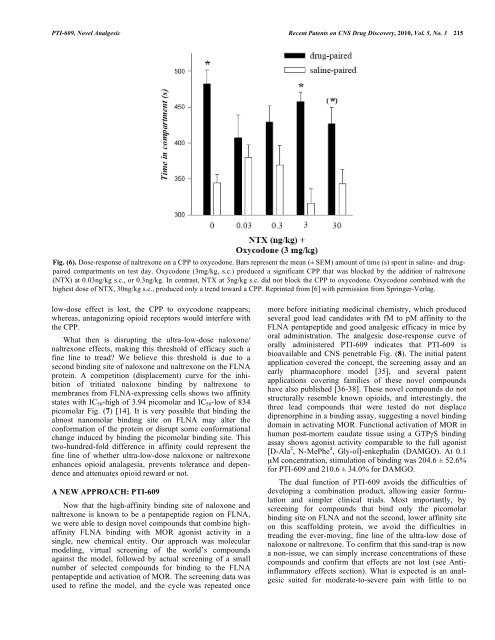PTI-609: A Novel Analgesic that Binds Filamin A to Control Opioid ...
PTI-609: A Novel Analgesic that Binds Filamin A to Control Opioid ...
PTI-609: A Novel Analgesic that Binds Filamin A to Control Opioid ...
Create successful ePaper yourself
Turn your PDF publications into a flip-book with our unique Google optimized e-Paper software.
<strong>PTI</strong>-<strong>609</strong>, <strong>Novel</strong> <strong>Analgesic</strong> Recent Patents on CNS Drug Discovery, 2010, Vol. 5, No. 3 215Fig. (6). Dose-response of naltrexone on a CPP <strong>to</strong> oxycodone. Bars represent the mean (± SEM) amount of time (s) spent in saline- and drugpairedcompartments on test day. Oxycodone (3mg/kg, s.c.) produced a significant CPP <strong>that</strong> was blocked by the addition of naltrexone(NTX) at 0.03ng/kg s.c., or 0.3ng/kg. In contrast, NTX at 3ng/kg s.c. did not block the CPP <strong>to</strong> oxycodone. Oxycodone combined with thehighest dose of NTX, 30ng/kg s.c., produced only a trend <strong>to</strong>ward a CPP. Reprinted from [6] with permission from Springer-Verlag.low-dose effect is lost, the CPP <strong>to</strong> oxycodone reappears;whereas, antagonizing opioid recep<strong>to</strong>rs would interfere withthe CPP.What then is disrupting the ultra-low-dose naloxone/naltrexone effects, making this threshold of efficacy such afine line <strong>to</strong> tread? We believe this threshold is due <strong>to</strong> asecond binding site of naloxone and naltrexone on the FLNAprotein. A competition (displacement) curve for the inhibitionof tritiated naloxone binding by naltrexone <strong>to</strong>membranes from FLNA-expressing cells shows two affinitystates with IC 50 -high of 3.94 picomolar and IC 50 -low of 834picomolar Fig. (7) [14]. It is very possible <strong>that</strong> binding thealmost nanomolar binding site on FLNA may alter theconformation of the protein or disrupt some conformationalchange induced by binding the picomolar binding site. Thistwo-hundred-fold difference in affinity could represent thefine line of whether ultra-low-dose naloxone or naltrexoneenhances opioid analagesia, prevents <strong>to</strong>lerance and dependenceand attenuates opioid reward or not.A NEW APPROACH: <strong>PTI</strong>-<strong>609</strong>Now <strong>that</strong> the high-affinity binding site of naloxone andnaltrexone is known <strong>to</strong> be a pentapeptide region on FLNA,we were able <strong>to</strong> design novel compounds <strong>that</strong> combine highaffinityFLNA binding with MOR agonist activity in asingle, new chemical entity. Our approach was molecularmodeling, virtual screening of the world’s compoundsagainst the model, followed by actual screening of a smallnumber of selected compounds for binding <strong>to</strong> the FLNApentapeptide and activation of MOR. The screening data wasused <strong>to</strong> refine the model, and the cycle was repeated oncemore before initiating medicinal chemistry, which producedseveral good lead candidates with fM <strong>to</strong> pM affinity <strong>to</strong> theFLNA pentapeptide and good analgesic efficacy in mice byoral administration. The analgesic dose-response curve oforally administered <strong>PTI</strong>-<strong>609</strong> indicates <strong>that</strong> <strong>PTI</strong>-<strong>609</strong> isbioavailable and CNS penetrable Fig. (8). The initial patentapplication covered the concept, the screening assay and anearly pharmacophore model [35], and several patentapplications covering families of these novel compoundshave also published [36-38]. These novel compounds do notstructurally resemble known opioids, and interestingly, thethree lead compounds <strong>that</strong> were tested do not displacediprenorphine in a binding assay, suggesting a novel bindingdomain in activating MOR. Functional activation of MOR inhuman post-mortem caudate tissue using a GTPS bindingassay shows agonist activity comparable <strong>to</strong> the full agonist[D-Ala 2 , N-MePhe 4 , Gly-ol]-enkephalin (DAMGO). At 0.1μM concentration, stimulation of binding was 204.6 ± 52.6%for <strong>PTI</strong>-<strong>609</strong> and 210.6 ± 34.0% for DAMGO.The dual function of <strong>PTI</strong>-<strong>609</strong> avoids the difficulties ofdeveloping a combination product, allowing easier formulationand simpler clinical trials. Most importantly, byscreening for compounds <strong>that</strong> bind only the picomolarbinding site on FLNA and not the second, lower affinity siteon this scaffolding protein, we avoid the difficulties intreading the ever-moving, fine line of the ultra-low dose ofnaloxone or naltrexone. To confirm <strong>that</strong> this sand-trap is nowa non-issue, we can simply increase concentrations of thesecompounds and confirm <strong>that</strong> effects are not lost (see Antiinflamma<strong>to</strong>ryeffects section). What is expected is an analgesicsuited for moderate-<strong>to</strong>-severe pain with little <strong>to</strong> no


